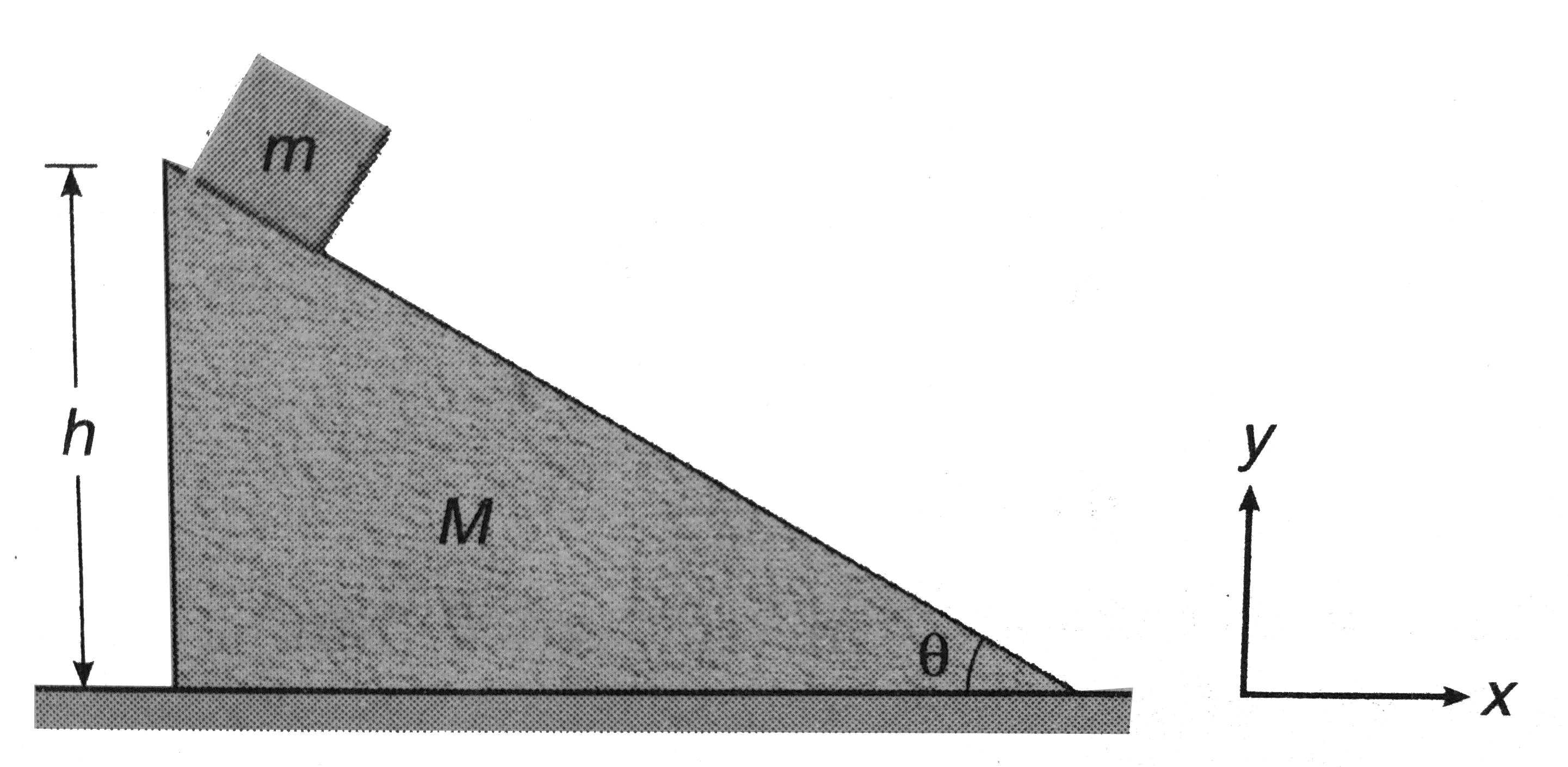A small block of mass m1 is released from rest at the top of a curve-shaped, frictionless wedge of mass m2 which sits on a frictionless horizontal surface as shown. When the block leaves the wedge its velocity is measured to be 4.00 m/s to the right as shown in the figure. if the mass of the block is doubled to becomes 2m1, what can be said about the speed with which it leaves the wedge ?

Its speed is less than 4.00 m/s
Its speed is equal to 4.00 m/s
Its speed is greter than 4.00 m/s
No enough information is given.
The correct Answer is:A
m1gh=12μV2_(rel)=12m1m2m1+m2v2_(rel)
vrel=√2gh(1+m1m2)
v1=v1c=μm1vrel
=m2m1+m2×√2ghm2+m1m2
=√2gh(m2m1+m2)
Topper's Solved these Questions
- TEST PAPERSBOOK - BANSALCHAPTER - TEST PAPERSEXERCISE - PHYSICS PART (A)
32 Videos
- TEST PAPERSBOOK - BANSALCHAPTER - TEST PAPERSEXERCISE - PHYSICS PART (B)
3 Videos
- TEST PAPERSBOOK - BANSALCHAPTER - TEST PAPERSEXERCISE - PHYSICS PART- C
4 Videos
- SEMICONDUCTORSBOOK - BANSALCHAPTER - SEMICONDUCTORSEXERCISE - CBSE Question
32 Videos
Similar Questions
A particle of mass m is placed at rest on the top of a smooth wedge of mass M, which in turn is placed at rest on a smooth horizontal surface as shown in figure. Then the distance moved by the wedge as the particle reaches the foot of the wedge is :

View SolutionA block of mass m is released from the top of a wedge of mass M as shown in figure. Find the displacement of wedges on the horizontal ground when the block reaches the bottom of the wedges. Neglect friction everywhere.

View Solution
Knowledge Check
A block of mass 1 kg is released from the top of a wedge of mass 2 kg. Height of wedge is 10 meter and all the surfaces are frictionless. Then
 ADisplacement of centre of mass of system in vertical direction is zero.BDisplacement of centre of mass of system, vertically downwards, is 103m,CRation of normal reaction between block and wedge to the acceleration of wedge w.r.t ground is 4 (in kg).DMomentum of system will not be conserved in horizontal direction.
ADisplacement of centre of mass of system in vertical direction is zero.BDisplacement of centre of mass of system, vertically downwards, is 103m,CRation of normal reaction between block and wedge to the acceleration of wedge w.r.t ground is 4 (in kg).DMomentum of system will not be conserved in horizontal direction.A small block of mass m is placed at rest on the top of a smooth wedge of mass M, which in turn is placed at rest on a smooth horizontal surface as shown in figure. It h be the height of wedge and θ is the inclination, then the distance moved by the wedge as the block reaches the foot of the wedge is
 AMhcotθM+mB(b) mhcotθM+mC(c) MhcosecθM+mD(d) mhcosecθM+m
AMhcotθM+mB(b) mhcotθM+mC(c) MhcosecθM+mD(d) mhcosecθM+mA block of mass 2kg slides down the face of a smooth 45∘ wedge of mass 9kg as shown in the figure. The wedge is placed on a frictionless horizontal surface. Determine the acceleration of the wedge.
 A2ms−2B11√2ms−2C1ms−2Dnone of these
A2ms−2B11√2ms−2C1ms−2Dnone of these
A particle of mass m is released from rest from a point A of a wedge of mass 4m free to slide on a frictionless horizontal plane.The particle slides down the smooth face AB of the wedge.When the velocity of the wedge is 0.2m/s the velocity of the particle in m/s relative to the wedge is
View SolutionA particle of mass m is released from rest from a point A of a wedge of mass 4m free to slide on a frictionless horizontal plane. The particle slides down the smooth face AB of the wedge. When the velocity of the wedge is 0.2 m/s the velocity of the particle in m/s relative to the wedge is
View SolutionA particle of mass m is released from rest from a point A of a wedge of mass 4m free to slide on a frictionless horizontal plane. The particle slides down the smooth face AB of the wedge. When the velocity of the wedge is 0.2 m/s the velocity of the particle in m/s relative to the wedge is
View SolutionA block of mass m slides along a frictionless surfce as shown in the figure. If it is releases from rest t A what is its speed at B?

View SolutionA block of mass m rests on a stationary wedge of mass M. The wedge can slide freely on a smooth horizontal surface as shown in figure. If the block starts from rest

View Solution
